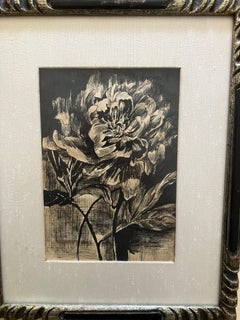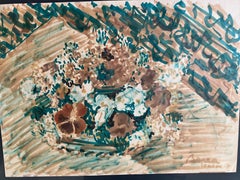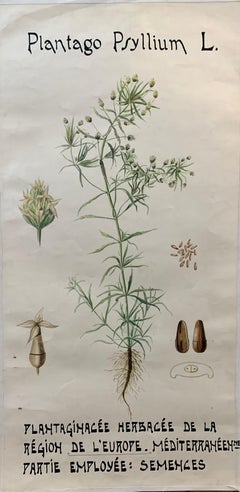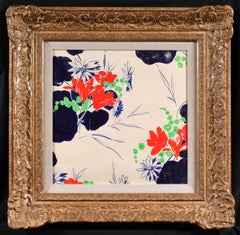Quintessential Things Still-life Drawings and Watercolors
to
3
1
1
Overall Width
to
Overall Height
to
1
4
1
1
1
3
2
2
2
1
1
1
1
1
1
3
3
2
1
1
4
5
Mystery Signed Pen and Ink Floral
Located in San Francisco, CA
Up for sale another mystery piece. This wonderfully executed pen and ink is signed lower right but I cannot decipher it. Obviously drawn by a very well trained artist. This floral pi...
Category
Mid-20th Century Academic Still-life Drawings and Watercolors
Materials
Ink
Dimitri Berea Still Life
By Dimitrie Berea
Located in San Francisco, CA
Dimitri Berea: 1908-1975. Very well listed Romanian artist with Auction results over $15,000, but sells for much higher in galleries He painted in the post impressionistic style. He ...
Category
1950s Post-Impressionist Still-life Drawings and Watercolors
Materials
Watercolor
Alexander Pernot Couard Tropical Still Life
Located in San Francisco, CA
Alexander Pernot Couard: 1891-1960. He was an American painter, printmaker and book illustrator. he studied at the Art students League in NYC. He often visited Florida after the 1940s where he most likely painted this fabulous colorful tropical still life...
Category
Mid-20th Century Still-life Drawings and Watercolors
Materials
Watercolor
William C. Ostrander "A Tragedy in Still Life"
By William Cheesborou Ostrander
Located in San Francisco, CA
William C Ostrander: 1858-1933. Listed NYC and California artist. In the 19th century he taught at Metropolitan Museum of Art in NYC. His works are very scarce as I could only find o...
Category
19th Century American Realist Still-life Drawings and Watercolors
Materials
Ink
Latin American Women w/ Calla Lilies Original Watercolor by Sabine
Located in San Francisco, CA
Latin American Women w/ Calla Lilies Original Watercolor by Sabine
A beautiful original watercolor of three Latin American women (Peruvian / Bolivian) with Calla Lilies.
Signed in ...
Category
Late 20th Century Impressionist Figurative Drawings and Watercolors
Materials
Watercolor
Related Items
Early 20th C French Watercolor, botanical flowers from an University collection
Located in Woodbury, CT
Wonderful watercolor depicting a plant/flower. These were used at a Belgium University to teach the students about botany. Dating from the early 20th century. They are watercolor on ...
Category
Early 1900s Art Nouveau Still-life Paintings
Materials
Watercolor
Projet de Tissus - Fauvist Flowers Watercolor & Gouache by Raoul Dufy
By Raoul Dufy
Located in Marlow, Buckinghamshire
Botanical watercolour and gouache on paper circa 1920 by French fauvist painter Raoul Dufy. The work depicts flowers in red, blue and green. This work was executed by Dufy as a fabric design.
Dimensions:
Framed: 19.5"x19.5"
Unframed: 12"x12"
Provenance:
Private collection of works by Raoul Dufy for Bianchini Ferier
Bianchini Ferrier Collection - Christie's London - July 2001
SF Fall Show
Raoul Dufy was one of a family of nine children, including five sisters and a younger brother, Jean Dufy, also destined to become a painter. Their father was an accountant in the employ of a major company in Le Havre. The Dufy family was musically gifted: his father was an organist, as was his brother Léon, and his youngest brother Gaston was an accomplished flautist who later worked as a music critic in Paris. Raoul Dufy's studies were interrupted at the age of 14, when he had to contribute to the family income. He took a job with an importer of Brazilian coffee, but still found time from 1892 to attend evening courses in drawing and composition at the local college of fine arts under Charles Marie Lhullier, former teacher of Othon Friesz and Georges Braque. He spent his free time in museums, admiring the paintings of Eugène Boudin in Le Havre and The Justice of Trajan in Rouen. A municipal scholarship enabled him to leave for Paris in 1900, where he lodged initially with Othon Friesz. He was accepted by the École des Beaux-Arts, where he studied under Léon Bonnat, whose innate conservatism prompted Dufy to remark later that it was 'good to be at the Beaux-Arts providing one knew one could leave'.
And leave he did, four years later, embarking with friends and fellow students on the rounds of the major Paris galleries - Ambroise Vollard, Durand-Ruel, Eugène Blot and Berheim-Jeune. For Dufy and his contemporaries, Impressionism represented a rejection of sterile academism in favour of the open-air canvases of Manet, the light and bright colours of the Impressionists, and, beyond them, the daringly innovative work of Gauguin and Van Gogh, Seurat, Cézanne, Toulouse-Lautrec and others. Dufy was an out-and-out individualist, however, and was not tempted to imitate any of these artists. He produced, between 1935 and 1937, Fée Electricité (Spirit of Electricity), the emblem for the French utilities company Electricité de France (EDF).
Dufy visited the USA for the first time in 1937, as a member of the Carnegie Prize jury. In 1940, the outbreak of war (and his increasingly rheumatic condition) persuaded him to settle in Nice. When he eventually returned to Paris 10 years later, his rheumatism had become so debilitating that he immediately left for Boston to follow a course of pioneering anti-cortisone treatment. He continued working, however, spending time first in Harvard and then in New York City before moving to the drier climate of Tucson, Arizona. The cortisone treatment was by and large unsuccessful, although he did recover the use of his fingers. He returned to Paris in 1951 and decided to settle in Forcalquier, where the climate was more clement. Within a short time, however, he was wheelchair-bound. He died in Forcalquier in March 1953 and was buried in Cimiez.
Between 1895 and 1898, Raoul Dufy painted watercolours of landscapes near his native Le Havre and around Honfleur and Falaise. By the turn of the century, however, he was already painting certain subjects that were to become hallmarks of his work - flag-decked Parisian cityscapes, Normandy beaches teeming with visitors, regattas and the like, including one of his better-known early works, Landing Stage at Ste-Adresse. By 1905-1906 Friesz, Braque, Matisse, Derain, Vlaminck, Van Dongen and Rouault were described collectively as Fauves (the wild beasts). What they had in common was a desire to innovate, but they felt constrained nonetheless to meet formally to set out the guiding principles of what promised to be a new 'movement'. Dufy quickly established that those principles were acceptable; moreover, he was most impressed by one particular painting by Henri Matisse ( Luxury, Calm and Voluptuousness) which, to Dufy, embodied both novelty and a sense of artistic freedom. Dufy promptly aligned himself with the Fauves. Together with Albert Marquet in particular, he spent his time travelling the Normandy coast and painting views similar...
Category
1920s Fauvist Still-life Drawings and Watercolors
Materials
Paper, Watercolor, Gouache
$12,678
H 19.5 in W 19.5 in
Gun from Clue
By A.J. Fries
Located in Buffalo, NY
An original mixed media drawing by American artist A.J. Fries.
Category
21st Century and Contemporary Realist Figurative Drawings and Watercolors
Materials
Gouache, Graphite, Paper
Cyclamen - Botanical Study
By Deborah Eddy
Located in Soquel, CA
Delicate watercolor, pen and ink floral study of a cyclamen blending into line drawing, with brilliant attention to detail and a signature delicate style, by California artist Debora...
Category
1980s American Realist Still-life Drawings and Watercolors
Materials
Paper, Ink, Watercolor
Paul Lecomte (1842-1920) A Flowerbed, signed watercolor
By Paul Lecomte
Located in Paris, FR
Paul Lecomte (1842-1920)
A Flowerbed
signed lower left
Watercolor on paper,
15.5 x 23.5 cm
Framed : 25.5 x 33 cm
This is a particularly original work by Paul Lecomte. It shows his ...
Category
1880s Impressionist Still-life Drawings and Watercolors
Materials
Watercolor
$1,148
H 6.11 in W 9.26 in
Bluebells - Blue Abstract Floral Painting on Paper
Located in Los Angeles, CA
Xiao Wen Xu is a Chinese-born Canadian artist based in Toronto, Canada, Her artistic practice is deeply influenced by her profound appreciation for the natural world. In her series, ...
Category
2010s Contemporary Still-life Drawings and Watercolors
Materials
Paper, Watercolor
Magnolia - Vibrant Floral Painting on Paper
Located in Los Angeles, CA
Xiao Wen Xu is a Chinese-born Canadian artist based in Toronto, Canada, Her artistic practice is deeply influenced by her profound appreciation for the natural world. In her series, ...
Category
2010s Contemporary Still-life Drawings and Watercolors
Materials
Paper, Powder Coating, Watercolor
Bellflower - Colorful Abstract Floral Painting on Paper
Located in Los Angeles, CA
Xiao Wen Xu is a Chinese-born Canadian artist based in Toronto, Canada, Her artistic practice is deeply influenced by her profound appreciation for the natural world. In her series, ...
Category
2010s Contemporary Still-life Drawings and Watercolors
Materials
Paper, Watercolor, Powder Coating
“Roses in a Porcelain Vase”
By Marcel Vertès
Located in Southampton, NY
Here for your consideration is a very well executed oil pastel on archival paper by the well known French artist, Marcel Vertes. Signed lower right. Condition is excellent. Circa 1...
Category
1930s Post-Impressionist Still-life Drawings and Watercolors
Materials
Oil Pastel, Archival Paper
Rainbowland Calla Lily Leaves II - Colorful Still Life Painting on Paper
Located in Los Angeles, CA
Xiao Wen Xu is a Chinese-born Canadian artist based in Toronto, Canada, Her artistic practice is deeply influenced by her profound appreciation for the natural world. In her series, ...
Category
2010s Contemporary Still-life Drawings and Watercolors
Materials
Paper, Watercolor, Gouache
"Daffodils in Ceramic Pitcher"
Located in Southampton, NY
Here for your consideration is a beautiful watercolor still life on heavy paper by the German artist, E. Riehle. Signed and dated lower right, 1903. In good condition with it's orig...
Category
Early 1900s Academic Still-life Drawings and Watercolors
Materials
Paper, Watercolor
Projet de Fleurs - Fauvist Flowers Gouache by Raoul Dufy
By Raoul Dufy
Located in Marlow, Buckinghamshire
Botanical gouache on paper circa 1920 by French fauvist painter Raoul Dufy. The work flowers in red and blues with green foliage against a yellow and white stripped background.
Dimensions:
Framed: 25"x20"
Unframed: 18"x13"
Raoul Dufy was one of a family of nine children, including five sisters and a younger brother, Jean Dufy, also destined to become a painter. Their father was an accountant in the employ of a major company in Le Havre. The Dufy family was musically gifted: his father was an organist, as was his brother Léon, and his youngest brother Gaston was an accomplished flautist who later worked as a music critic in Paris. Raoul Dufy's studies were interrupted at the age of 14, when he had to contribute to the family income. He took a job with an importer of Brazilian coffee, but still found time from 1892 to attend evening courses in drawing and composition at the local college of fine arts under Charles Marie Lhullier, former teacher of Othon Friesz and Georges Braque. He spent his free time in museums, admiring the paintings of Eugène Boudin in Le Havre and The Justice of Trajan in Rouen. A municipal scholarship enabled him to leave for Paris in 1900, where he lodged initially with Othon Friesz. He was accepted by the École des Beaux-Arts, where he studied under Léon Bonnat, whose innate conservatism prompted Dufy to remark later that it was 'good to be at the Beaux-Arts providing one knew one could leave'.
And leave he did, four years later, embarking with friends and fellow students on the rounds of the major Paris galleries - Ambroise Vollard, Durand-Ruel, Eugène Blot and Berheim-Jeune. For Dufy and his contemporaries, Impressionism represented a rejection of sterile academism in favour of the open-air canvases of Manet, the light and bright colours of the Impressionists, and, beyond them, the daringly innovative work of Gauguin and Van Gogh, Seurat, Cézanne, Toulouse-Lautrec and others. Dufy was an out-and-out individualist, however, and was not tempted to imitate any of these artists. He produced, between 1935 and 1937, Fée Electricité (Spirit of Electricity), the emblem for the French utilities company Electricité de France (EDF).
Dufy visited the USA for the first time in 1937, as a member of the Carnegie Prize jury. In 1940, the outbreak of war (and his increasingly rheumatic condition) persuaded him to settle in Nice. When he eventually returned to Paris 10 years later, his rheumatism had become so debilitating that he immediately left for Boston to follow a course of pioneering anti-cortisone treatment. He continued working, however, spending time first in Harvard and then in New York City before moving to the drier climate of Tucson, Arizona. The cortisone treatment was by and large unsuccessful, although he did recover the use of his fingers. He returned to Paris in 1951 and decided to settle in Forcalquier, where the climate was more clement. Within a short time, however, he was wheelchair-bound. He died in Forcalquier in March 1953 and was buried in Cimiez.
Between 1895 and 1898, Raoul Dufy painted watercolours of landscapes near his native Le Havre and around Honfleur and Falaise. By the turn of the century, however, he was already painting certain subjects that were to become hallmarks of his work - flag-decked Parisian cityscapes, Normandy beaches teeming with visitors, regattas and the like, including one of his better-known early works, Landing Stage at Ste-Adresse. By 1905-1906 Friesz, Braque, Matisse, Derain, Vlaminck, Van Dongen and Rouault were described collectively as Fauves (the wild beasts). What they had in common was a desire to innovate, but they felt constrained nonetheless to meet formally to set out the guiding principles of what promised to be a new 'movement'. Dufy quickly established that those principles were acceptable; moreover, he was most impressed by one particular painting by Henri Matisse ( Luxury, Calm and Voluptuousness) which, to Dufy, embodied both novelty and a sense of artistic freedom. Dufy promptly aligned himself with the Fauves. Together with Albert Marquet in particular, he spent his time travelling the Normandy coast and painting views similar...
Category
1920s Fauvist Still-life Drawings and Watercolors
Materials
Gouache, Paper




